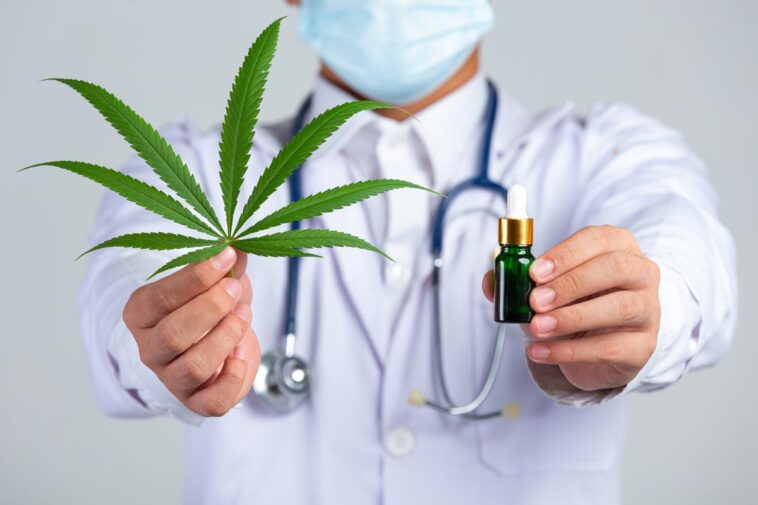Medical marijuana, also known as medicinal cannabis, has gained significant attention in recent years for its potential therapeutic benefits. With its active compounds known as cannabinoids, medical marijuana has shown promise in managing a wide range of conditions.
In this blog post, we will explore the science behind medical marijuana, its role in pain management, mental health disorders, nausea and vomiting, neurological conditions, sleep disorders, appetite stimulation, and inflammatory conditions, and discuss potential side effects and considerations. By the end, you will have a comprehensive understanding of the potential benefits medical marijuana can offer.
Exploring the Science: How Cannabinoids Interact with the Body
Cannabinoids are chemical compounds that interact with specific receptors in the body’s endocannabinoid system. This system, which plays a crucial role in regulating various physiological processes such as pain, mood, appetite, and inflammation, holds the key to understanding the potential benefits. The two primary cannabinoids found in it, tetrahydrocannabinol (THC) and cannabidiol (CBD), have distinct effects. THC is responsible for the psychoactive effects commonly associated with marijuana, while CBD offers potential therapeutic benefits without causing intoxication. Recognizing how these cannabinoids interact with the body forms the foundation for comprehending their potential in managing various conditions, making it a subject of interest in clinics, including those in Marijuana Clinic West Palm Beach.
Pain Management: The Role of Medical Marijuana in Alleviating Chronic Pain
Chronic pain can be debilitating and significantly impact a person’s quality of life. Medical marijuana has emerged as a potential alternative for pain management, particularly in cases where traditional therapies have proven ineffective. Both THC and CBD have shown analgesic properties, reducing pain intensity and improving the overall well-being of individuals suffering from chronic pain conditions such as fibromyalgia, neuropathic pain, and arthritis.
Mental Health Disorders: Using Medical Marijuana to Treat Anxiety and Depression

Anxiety and depression affect millions of people worldwide, and conventional treatments may not be suitable for everyone. Medical marijuana has shown promise in alleviating symptoms associated with these mental health disorders. CBD, in particular, has demonstrated anxiolytic and antidepressant effects, offering a potential natural option for individuals seeking relief. However, it is essential to note that the effects on mental health can vary depending on the individual and the specific condition.
Nausea and Vomiting: How Medical Marijuana Can Provide Relief for Cancer Patients
Cancer treatments such as chemotherapy often induce severe nausea and vomiting, significantly impacting patients’ quality of life. Specifically, THC has shown antiemetic properties, effectively reducing these symptoms and allowing cancer patients to better tolerate their treatments. Additionally, it can stimulate appetite, which is essential for maintaining proper nutrition during cancer therapy.
Neurological Conditions: The Potential in Managing Epilepsy and Multiple Sclerosis
Neurological conditions like epilepsy and multiple sclerosis (MS) can be challenging to manage with conventional treatments alone. However, medical marijuana has demonstrated the potential in reducing seizures in certain types of epilepsy, such as Dravet syndrome and Lennox-Gastaut syndrome. CBD, in particular, has gained recognition for its anticonvulsant properties. Furthermore, medical marijuana may help alleviate symptoms associated with MS, such as muscle spasms and pain. While more research is needed to fully understand the mechanisms and efficacy, it offers a potential complementary treatment option for individuals living with these neurological conditions.
Sleep Disorders: Using It to Improve Sleep Quality and Address Insomnia

Sleep disorders, including insomnia, affect a significant portion of the population and can lead to various health issues. It has shown promise in improving sleep quality and addressing insomnia symptoms. THC’s sedative properties can help initiate sleep, while CBD may promote wakefulness during the day and regulate sleep-wake cycles. However, it is crucial to consider individual variations in response and the potential for dependence or rebound insomnia with long-term use. It should be used under the guidance of a healthcare professional to ensure appropriate dosing and monitor its effects on sleep patterns.
Appetite Stimulation: Medical Marijuana as a Treatment for Appetite Loss and Eating Disorders
Appetite loss and eating disorders can have severe consequences on an individual’s physical and mental well-being. Medical marijuana’s ability to stimulate appetite, often referred to as “the munchies,” can be beneficial in cases where appetite needs to be restored. This effect is primarily associated with THC. It may also help address the underlying psychological factors contributing to eating disorders by reducing anxiety and depression symptoms. However, it is important to approach these conditions holistically and involve a comprehensive treatment plan that includes therapy and nutritional support alongside medical marijuana, when appropriate.
Inflammatory Conditions: How Medical Marijuana Can Help Reduce Inflammation in Conditions like Arthritis
Inflammatory conditions such as arthritis can cause chronic pain and significant discomfort. Medical marijuana’s anti-inflammatory properties offer potential relief by reducing inflammation and alleviating associated symptoms. Both THC and CBD have shown anti-inflammatory effects in preclinical and clinical studies.
It may help manage pain, stiffness, and joint swelling, improving the quality of life for individuals with inflammatory conditions. It is crucial to note that it should be used as part of a comprehensive treatment approach, and regular communication with a healthcare professional is essential for monitoring its effectiveness and safety.
Side Effects and Considerations: Discussing Potential Risks and Precautions

While medical marijuana offers potential benefits for various conditions, it is essential to consider the potential risks and precautions. Common side effects include dry mouth, dizziness, fatigue, and changes in appetite. Additionally, THC can cause psychoactive effects, affecting cognitive function and impairing driving skills.
It is important to start with low doses, monitor individual response, and adjust the treatment plan accordingly. It may interact with certain medications, and individuals with a history of substance abuse or mental health disorders should exercise caution. Consulting with a healthcare professional knowledgeable in it is crucial to ensure safe and effective use.
Conclusion: Summarizing the Benefits and Potential
Medical marijuana offers a promising alternative for individuals seeking relief from various conditions, including chronic pain, mental health disorders, nausea and vomiting, neurological conditions, sleep disorders, appetite loss, and inflammatory conditions. With its cannabinoids interacting with the body’s endocannabinoid system, it can provide analgesia, antiemetic, anticonvulsant, anti-inflammatory, and sleep-enhancing effects.
However, it is important to approach its use with caution, considering potential side effects and individual variations in response. With further research and professional guidance, medical marijuana has the potential to improve the lives of many individuals, providing them with much-needed relief and enhanced well-being.




